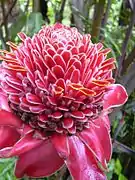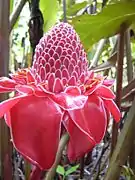Etlingera elatior
Etlingera elatior (also known as torch ginger, ginger flower, red ginger lily, torch lily, wild ginger, combrang, bunga kantan, Philippine wax flower, ගොඩ ඕලු (goda olu), ගොඩ නෙලුම් (goda nelum), සිද්ධාර්ථ (siddartha), 火炬姜 (pinyin: Huǒjù jiāng), Indonesian tall ginger, boca de dragón, rose de porcelaine, and porcelain rose) is a species of herbaceous perennial plant. Botanical synonyms include Nicolaia elatior,[1] Phaeomeria magnifica,[1] Nicolaia speciosa, Phaeomeria speciosa, Alpinia elatior, and Alpinia magnifica.
| Etlingera elatior | |
|---|---|
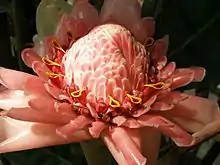 | |
| Scientific classification | |
| Kingdom: | Plantae |
| Clade: | Tracheophytes |
| Clade: | Angiosperms |
| Clade: | Monocots |
| Clade: | Commelinids |
| Order: | Zingiberales |
| Family: | Zingiberaceae |
| Genus: | Etlingera |
| Species: | E. elatior |
| Binomial name | |
| Etlingera elatior (Jack) R.M.Sm. | |
| Synonyms | |
| |
The showy pink flowers are used in decorative arrangements, bunga kecombrang, are an important ingredient across Southeast Asia. In North Sumatra (especially among the Karo people), the flower buds are used for a stewed fish dish called Arsik ikan mas (Andaliman/Szechuan pepper-spiced carp). In Bali, people use the white part of the bottom part of the trunk for cooking chilli sauce called "Sambal Bongkot", and use the flower buds to make chilli sauce called "Sambal Kecicang". In Thailand, it is eaten in a kind of Thai salad preparation.[2] The fruit is also used in Indonesian cooking.[3]
In Karo, it is known as asam cekala (asam meaning 'sour'), and the flower buds, but more importantly the ripe seed pods, which are packed with small black seeds, are an essential ingredient of the Karo version of sayur asam, and are particularly suited to cooking fresh fish. In Sundanese, it is known as Honje.
Chemistry
From the leaves of E. elatior, three caffeoylquinic acids, including chlorogenic acid (CGA), and three flavonoids, quercitrin, isoquercitrin and catechin, have been isolated.[4] Content of CGA was significantly higher than flowers of Lonicera japonica (Japanese honeysuckle), the commercial source.[5] A protocol for producing a standardized herbal extract of CGA from leaves of E. elatior (40%) has been developed, compared to commercial CGA extracts from honeysuckle flowers (25%).[4]
Gallery
- Etlingera elatior
Similar species
References
- Riffle, Robert Lee (1998). The tropical look: an encyclopedia of dramatic landscape plants, Timber Press, ISBN 978-0-88192-422-0, p. 167
- ความคิดเห็นที่ 15 - สวัสดีครับป้าอัม ลุงไก่
- "Etlingera elatior (torch ginger)". cabi.org. Retrieved 19 January 2021.
- Chan, E.W.C. (2009). “Bioactivities and chemical constituents of leaves of some Etlingera species (Zingiberaceae) in Peninsular Malaysia”. Ph.D. thesis, Monash University, 305 p., http://arrow.monash.edu.au/hdl/1959.1/149589 Archived 2012-12-03 at Archive.today
- Chan, E.W.C.; Lim, Y.Y.; Ling, S.K.; Tan, S.P.; Lim, K.K.; Khoo, M.G.H.; et al. (2009). "Caffeoylquinic acids from leaves of Etlingera species (Zingiberaceae)". LWT - Food Science and Technology. 42 (5): 1026–1030. doi:10.1016/j.lwt.2009.01.003.
- Chan, E.W.C.; Lim, Y.Y.; Wong, L.F.; Lianto, F.S.; Wong, S.K.; Lim, K.K.; Joe, C.E.; Lim, T.Y.; et al. (2008). "Antioxidant and tyrosinase inhibition properties of leaves and rhizomes of ginger species". Food Chemistry. 109 (3): 477–483. doi:10.1016/j.foodchem.2008.02.016.
- Chan, E.W.C.; Lim, Y; Wong, S; Lim, K; Tan, S; Lianto, F; Yong, M; et al. (2009). "Effects of different drying methods on the antioxidant properties of leaves and tea of ginger species". Food Chemistry. 113 (1): 166–172. doi:10.1016/j.foodchem.2008.07.090.
| Wikimedia Commons has media related to Etlingera elatior. |
| Wikispecies has information related to Etlingera elatior. |
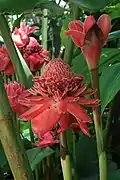
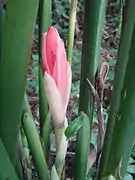

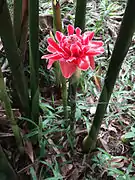
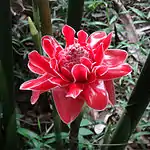

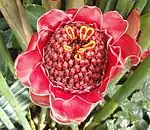
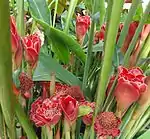
_001.jpg.webp)

